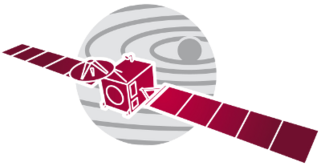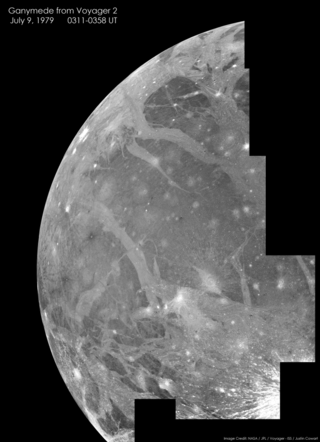
A comet is an icy,small Solar System body that warms and begins to release gases when passing close to the Sun,a process called outgassing. This produces an extended,gravitationally unbound atmosphere or coma surrounding the nucleus,and sometimes a tail of gas and dust gas blown out from the coma. These phenomena are due to the effects of solar radiation and the outstreaming solar wind plasma acting upon the nucleus of the comet. Comet nuclei range from a few hundred meters to tens of kilometers across and are composed of loose collections of ice,dust,and small rocky particles. The coma may be up to 15 times Earth's diameter,while the tail may stretch beyond one astronomical unit. If sufficiently close and bright,a comet may be seen from Earth without the aid of a telescope and can subtend an arc of up to 30°across the sky. Comets have been observed and recorded since ancient times by many cultures and religions.

The Mariner program was conducted by the American space agency NASA to explore other planets. Between 1962 and late 1973,NASA's Jet Propulsion Laboratory (JPL) designed and built 10 robotic interplanetary probes named Mariner to explore the inner Solar System –visiting the planets Venus,Mars and Mercury for the first time,and returning to Venus and Mars for additional close observations.

Ulysses was a robotic space probe whose primary mission was to orbit the Sun and study it at all latitudes. It was launched in 1990 and made three "fast latitude scans" of the Sun in 1994/1995,2000/2001,and 2007/2008. In addition,the probe studied several comets. Ulysses was a joint venture of the European Space Agency (ESA) and the United States' National Aeronautics and Space Administration (NASA),under leadership of ESA with participation from Canada's National Research Council. The last day for mission operations on Ulysses was 30 June 2009.

Cassini–Huygens,commonly called Cassini,was a space-research mission by NASA,the European Space Agency (ESA),and the Italian Space Agency (ASI) to send a space probe to study the planet Saturn and its system,including its rings and natural satellites. The Flagship-class robotic spacecraft comprised both NASA's Cassini space probe and ESA's Huygens lander,which landed on Saturn's largest moon,Titan. Cassini was the fourth space probe to visit Saturn and the first to enter its orbit,where it stayed from 2004 to 2017. The two craft took their names from the astronomers Giovanni Cassini and Christiaan Huygens.

Giotto was a European robotic spacecraft mission from the European Space Agency. The spacecraft flew by and studied Halley's Comet and in doing so became the first spacecraft to make close up observations of a comet. On 13 March 1986,the spacecraft succeeded in approaching Halley's nucleus at a distance of 596 kilometers. It was named after the Early Italian Renaissance painter Giotto di Bondone. He had observed Halley's Comet in 1301 and was inspired to depict it as the star of Bethlehem in his painting Adoration of the Magi in the Scrovegni Chapel.

The Comet Nucleus Tour (CONTOUR) was a NASA Discovery-class space probe that failed shortly after its July 2002 launch. It was the only Discovery mission to fail.

A gravity assist,gravity assist maneuver,swing-by,or generally a gravitational slingshot in orbital mechanics,is a type of spaceflight flyby which makes use of the relative movement and gravity of a planet or other astronomical object to alter the path and speed of a spacecraft,typically to save propellant and reduce expense.

Rosetta was a space probe built by the European Space Agency launched on 2 March 2004. Along with Philae,its lander module,Rosetta performed a detailed study of comet 67P/Churyumov–Gerasimenko (67P). During its journey to the comet,the spacecraft performed flybys of Earth,Mars,and the asteroids 21 Lutetia and 2867 Šteins. It was launched as the third cornerstone mission of the ESA's Horizon 2000 programme,after SOHO / Cluster and XMM-Newton.

Stardust was a 385-kilogram robotic space probe launched by NASA on 7 February 1999. Its primary mission was to collect dust samples from the coma of comet Wild 2,as well as samples of cosmic dust,and return them to Earth for analysis. It was the first sample return mission of its kind. En route to Comet Wild 2,it also flew by and studied the asteroid 5535 Annefrank. The primary mission was successfully completed on 15 January 2006 when the sample return capsule returned to Earth.

The Discovery Program is a series of Solar System exploration missions funded by the U.S. National Aeronautics and Space Administration (NASA) through its Planetary Missions Program Office. The cost of each mission is capped at a lower level than missions from NASA's New Frontiers or Flagship Programs. As a result,Discovery missions tend to be more focused on a specific scientific goal rather than serving a general purpose.

Deep Impact was a NASA space probe launched from Cape Canaveral Air Force Station on January 12,2005. It was designed to study the interior composition of the comet Tempel 1 (9P/Tempel),by releasing an impactor into the comet. At 05:52 UTC on July 4,2005,the Impactor successfully collided with the comet's nucleus. The impact excavated debris from the interior of the nucleus,forming an impact crater. Photographs taken by the spacecraft showed the comet to be more dusty and less icy than had been expected. The impact generated an unexpectedly large and bright dust cloud,obscuring the view of the impact crater.

Mariner Mark II was NASA's planned family of uncrewed spacecraft for the exploration of the outer Solar System that were to be developed and operated by JPL between 1980 through the year 2010.

The nucleus is the solid,central part of a comet,formerly termed a dirty snowball or an icy dirtball. A cometary nucleus is composed of rock,dust,and frozen gases. When heated by the Sun,the gases sublime and produce an atmosphere surrounding the nucleus known as the coma. The force exerted on the coma by the Sun's radiation pressure and solar wind cause an enormous tail to form,which points away from the Sun. A typical comet nucleus has an albedo of 0.04. This is blacker than coal,and may be caused by a covering of dust.
The New Frontiers program is a series of space exploration missions being conducted by NASA with the purpose of furthering the understanding of the Solar System. The program selects medium-class missions which can provide high science returns.

Comet Hartley 2,designated as 103P/Hartley by the Minor Planet Center,is a small periodic comet with an orbital period of 6.48 years. It was discovered by Malcolm Hartley in 1986 at the Schmidt Telescope Unit,Siding Spring Observatory,Australia. Its diameter is estimated to be 1.2 to 1.6 kilometres.

C/2013 A1 is an Oort cloud comet discovered on 3 January 2013 by Robert H. McNaught at Siding Spring Observatory using the 0.5-meter (20 in) Uppsala Southern Schmidt Telescope.

A flyby is a spaceflight operation in which a spacecraft passes in proximity to another body,usually a target of its space exploration mission and/or a source of a gravity assist to impel it towards another target. Spacecraft which are specifically designed for this purpose are known as flyby spacecraft,although the term has also been used in regard to asteroid flybys of Earth for example. Important parameters are the time and distance of closest approach.
Chimera is a NASA mission concept to orbit and explore 29P/Schwassmann-Wachmann 1 (SW1),an active,outbursting small icy body in the outer Solar System. The concept was developed in response to the 2019 NASA call for potential missions in the Discovery-class,and it would have been the first spacecraft encounter with a Centaur and the first orbital exploration of a small body in the outer Solar System. The Chimera proposal was ranked in the first tier of submissions,but was not selected for further development for the programmatic reason of maintaining scientific balance.

C/2014 UN271 (Bernardinelli–Bernstein),simply known as C/2014 UN271 or Comet Bernardinelli–Bernstein (nicknamed BB),is a large Oort cloud comet discovered by astronomers Pedro Bernardinelli and Gary Bernstein in archival images from the Dark Energy Survey. When first imaged in October 2014,the object was 29 AU (4.3 billion km;2.7 billion mi) from the Sun,almost as far as Neptune's orbit and the greatest distance at which a comet has been discovered. With a nucleus diameter of at least 120 km (75 mi),it is the largest Oort cloud comet known. It is approaching the Sun and will reach its perihelion of 10.9 AU (just outside of Saturn's orbit) in January 2031. It will not be visible to the naked eye because it will not enter the inner Solar System.





















